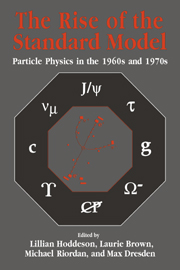Book contents
- Frontmatter
- Contents
- Contributors
- Editors' Acknowledgments
- Photographs of the Symposium
- Abbreviations and Acronyms
- Mathematical Notation
- Part One Introduction
- Part Two Quarks and Leptons
- Part Three Toward Gauge Theories
- Part Four Accelerators, Detectors, and Laboratories
- 15 The Rise of Colliding Beams
- 16 The CERN Intersecting Storage Rings: The Leap into the Hadron Collider Era
- 17 Development of Large Detectors for Colliding-Beam Experiments
- 18 Pure and Hybrid Detectors: Mark I and the Psi
- 19 Building Fermilab: A User's Paradise
- 20 Panel Session: Science Policy and the Social Structure of Big Laboratories
- 21 Some Sociological Consequences of High-Energy Physicists' Development of the Standard Model
- 22 Comments on Accelerators, Detectors, and Laboratories
- Part Five Electroweak Unification
- Part Six The Discovery of Quarks and Gluons
- Part Seven Personal Overviews
- Index
16 - The CERN Intersecting Storage Rings: The Leap into the Hadron Collider Era
Published online by Cambridge University Press: 03 February 2010
- Frontmatter
- Contents
- Contributors
- Editors' Acknowledgments
- Photographs of the Symposium
- Abbreviations and Acronyms
- Mathematical Notation
- Part One Introduction
- Part Two Quarks and Leptons
- Part Three Toward Gauge Theories
- Part Four Accelerators, Detectors, and Laboratories
- 15 The Rise of Colliding Beams
- 16 The CERN Intersecting Storage Rings: The Leap into the Hadron Collider Era
- 17 Development of Large Detectors for Colliding-Beam Experiments
- 18 Pure and Hybrid Detectors: Mark I and the Psi
- 19 Building Fermilab: A User's Paradise
- 20 Panel Session: Science Policy and the Social Structure of Big Laboratories
- 21 Some Sociological Consequences of High-Energy Physicists' Development of the Standard Model
- 22 Comments on Accelerators, Detectors, and Laboratories
- Part Five Electroweak Unification
- Part Six The Discovery of Quarks and Gluons
- Part Seven Personal Overviews
- Index
Summary
The history of colliding-beam devices can be traced back to 1956, when a group at the Midwestern Universities Research Association put forward the idea of particle stacking in circular accelerators. Of course, people who worked with particle accelerators had already speculated about the high center-of-mass energies attainable with colliding beams, but such ideas were unrealistic with the particle densities then available in normal accelerator beams. The invention of particle stacking fundamentally changed this situation. It opened up the possibility of making two intense proton beams collide with a sufficiently high interaction rate to enable experimentation in an energy range otherwise unattainable by known techniques.
A group at CERN started investigating this possibility in 1957, first by studying a special two-way fixed-field alternating gradient accelerator and then in 1960 by turning to the idea of two intersecting storage rings that could be fed from the CERN 28 GeV Proton Synchrotron (PS). This change in concept for these initial studies was stimulated by the promising performance of the PS at the very start of its operation in 1959.
In 1961 the Accelerator Research Division at CERN had gained sufficient confidence to present its first proposal for a 2 x 25 GeV storage ring system. This system was intended essentially for protons, but other particles were mentioned in the proposal. This led to a series of important actions. First, in 1962, France offered a site next to the original CERN site.
- Type
- Chapter
- Information
- The Rise of the Standard ModelA History of Particle Physics from 1964 to 1979, pp. 285 - 298Publisher: Cambridge University PressPrint publication year: 1997
- 1
- Cited by



